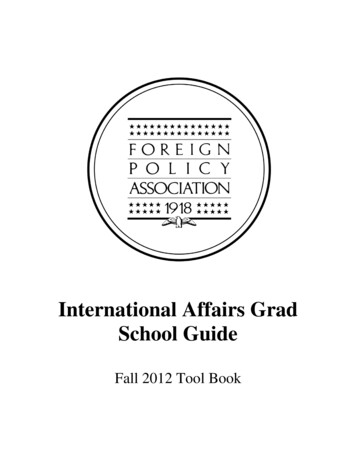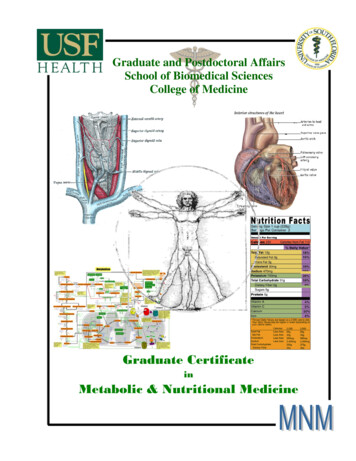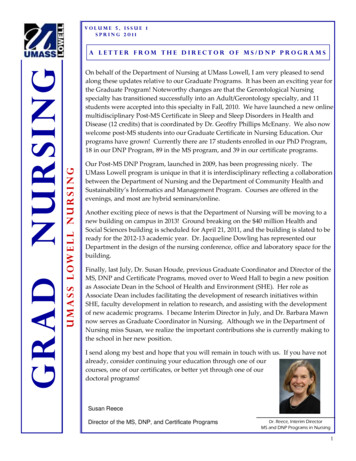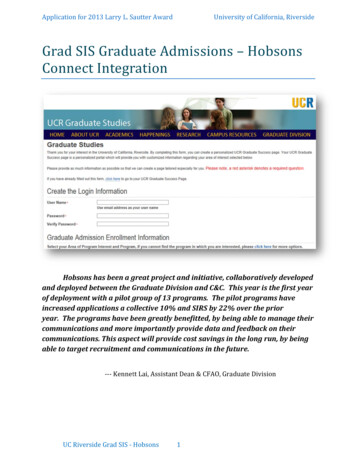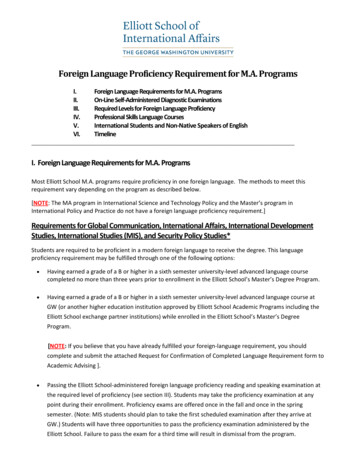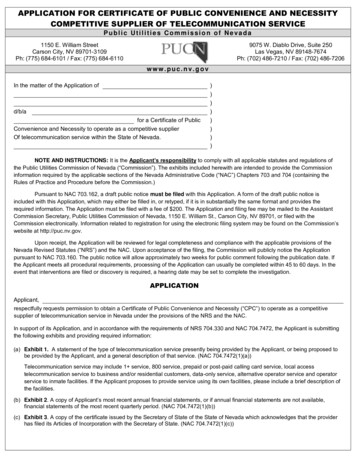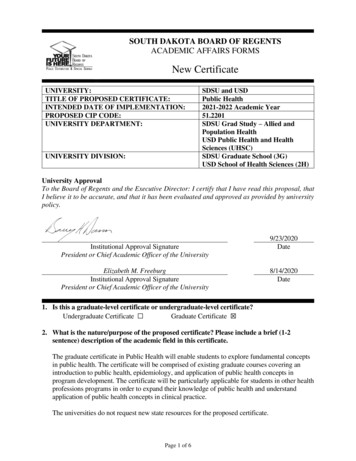
Transcription
SOUTH DAKOTA BOARD OF REGENTSACADEMIC AFFAIRS FORMSNew CertificateUNIVERSITY:TITLE OF PROPOSED CERTIFICATE:INTENDED DATE OF IMPLEMENTATION:PROPOSED CIP CODE:UNIVERSITY DEPARTMENT:UNIVERSITY DIVISION:SDSU and USDPublic Health2021-2022 Academic Year51.2201SDSU Grad Study – Allied andPopulation HealthUSD Public Health and HealthSciences (UHSC)SDSU Graduate School (3G)USD School of Health Sciences (2H)University ApprovalTo the Board of Regents and the Executive Director: I certify that I have read this proposal, thatI believe it to be accurate, and that it has been evaluated and approved as provided by universitypolicy.Institutional Approval SignaturePresident or Chief Academic Officer of the UniversityElizabeth M. FreeburgInstitutional Approval SignaturePresident or Chief Academic Officer of the University9/23/2020Date8/14/2020Date1. Is this a graduate-level certificate or undergraduate-level certificate?Undergraduate Certificate Graduate Certificate 2. What is the nature/purpose of the proposed certificate? Please include a brief (1-2sentence) description of the academic field in this certificate.The graduate certificate in Public Health will enable students to explore fundamental conceptsin public health. The certificate will be comprised of existing graduate courses covering anintroduction to public health, epidemiology, and application of public health concepts inprogram development. The certificate will be particularly applicable for students in other healthprofessions programs in order to expand their knowledge of public health and understandapplication of public health concepts in clinical practice.The universities do not request new state resources for the proposed certificate.Page 1 of 6
South Dakota State University & University of South DakotaNew Certificate: Public Health3. If you do not have a major in this field, explain how the proposed minor relates to youruniversity mission and strategic plan, and to the current Board of Regents Strategic Plan2014-2020.The graduate certificate in Public Health supports the health professions education mission ofSDSU and USD as provided in SDCL 13-58-1 and 13-57-1:Designated as South Dakota’s land grant university, South Dakota State University, formerlythe state college of agriculture and mechanical arts, shall be under the control of the Board ofRegents and shall provide undergraduate and graduate programs of instruction in the liberalarts and sciences and professional education in agriculture, education, engineering, homeeconomics, nursing and pharmacy, and other courses or programs as the Board of Regentsmay determine.Designated as South Dakota's Liberal Arts University, the University of South Dakota,established and located at Vermillion, in Clay County, shall be under the control of theBoard of Regents and shall provide undergraduate and graduate programs of instruction inthe liberal arts and sciences and professional education in business, education, fine arts, lawand medicine, and other courses or programs as the Board of Regents may determine.The proposed program also supports the goals stated in the South Dakota Board of RegentsStrategic Plan 2014-2020:Goal 1 – Student Success Increase the number of graduate degrees awarded.Goal 2 – Academic Quality and Performance Continue to approve new graduate programs.In addition, the Public Health Certificate supports goals and strategies of the universities’strategic plans:SDSU Strategic Goal1 – Excellence Through Transformative EducationAttain academic excellence: Develop and grow high-quality and distinct academicprograms designed to meet the needs of diverse students and market demands.USD Strategic Goal2 – Undergraduate, Graduate, and Professional Student ExperienceGoal 2: Enrich academic experiences for graduate and professional students.4. Provide a justification for the certificate program, including the potential benefits tostudents and potential workforce demand for those who graduate with the credential.1The public health profession is in high demand, and job growth projections from the UnitedStates Bureau of Labor Statistics indicate average to well above average growth (10 year jobgrowth of 5-11%, depending on area of specialization).2 Importantly, public health knowledgeis now recognized as an important component of the education of multiple health professions.Physicians, pharmacists, nurses, dieticians, and other health professionals are now utilizingpublic and population health knowledge in their clinical roles, and specialty positions forclinicians with a public health background are now available. For many of the clinicalapplications of public health, a bachelors or master’s degree in public health would not be1U.S. Bureau of Labor Statistics; Page 2 of 6
South Dakota State University & University of South DakotaNew Certificate: Public Healthrequired, but additional course work in public health beyond what is required in the mainprofessional curriculum would give graduates an advantage in pursuing these positions. Thiscertificate would provide foundational knowledge in public health and epidemiology as well asmore advanced training in program planning and evaluation and applied public health forstudents interested in adding public health training to another degree program. All of thecourses in the certificate would apply to the M.P.H. program so students would be able toproceed with further education if desired.5. Who is the intended audience for the certificate program (including but not limited to themajors/degree programs from which students are expected)?The main audience for the certificate would be students in other health professions majors suchas medicine, pharmacy, nursing, and dietetics would be interested in advancing theirknowledge of public health. Another audience for the certificate would be practicing clinicianswho would like to further their education in public health.6. Certificate DesignA. Is the certificate designed as a stand-alone education credential option for studentsnot seeking additional credentials (i.e., a bachelor’s or master’s degree)? If so, whatareas of high workforce demand or specialized body of knowledge will be addressedthrough this certificate?Practicing health care professionals could pursue this certificate as a stand-alone educationcredential to enhance their knowledge in public and population health. Hospitals andhealth-systems are expanding their work in population health. Health care professionalswith a certificate in public health would have knowledge and skill to work in this area.B. Is the certificate a value added credential that supplements a student’s major field ofstudy? If so, list the majors/programs from which students would most benefit fromadding the certificate.The proposed certificate could serve as a value-added credential that would supplement avariety of health-related programs. It will provide health professions majors with additionaltraining in public health and an additional credential for job opportunities utilizing theirprofessional training in public and population health applications.C. Is the certificate a stackable credential with credits that apply to a higher levelcredential (i.e., associate, bachelor’s, or master’s degree)? If so, indicate theprogram(s) to which the certificate stacks and the number of credits from thecertificate that can be applied to the program.Yes. The Public Health Certificate may be a stackable credential as all of the courses inthe certificate could be applied to the M.P.H program should the student decide tocontinue their education.Page 3 of 6
South Dakota State University & University of South DakotaNew Certificate: Public Health7. List the courses required for completion of the certificate in the table below (if any newcourses are proposed for the certificate, please attach the new course requests to thisform):2Prerequisites forCoursePrefixPUBHPUBHInclude credits forprerequisites insubtotal below.Number701702Course TitleBiostatistics in Public HealthPublic Health Theory andPracticePUBH 710EpidemiologySelect 2 courses (6 credits) from the following supporting course list:PUBH 733Environmental HealthPUBH 740US Health Systems and PublicPolicyPUBH750PUBH755PUBH760CreditNewHours (yes, no)3No3No3No33NoNoSocial and Behavioral Sciencesin Public HealthProgram Planning andEvaluation3No3NoPublic Health and NativeAmerican Communities3NoSubtotal15**USD and SDSU ask for an exception on the number of credit hours for this graduate certificate.Other certificates across the country in this discipline typically consist of 15-18 credit hours. Theincreased credits will allow the certificate to cover the five core areas of public health:biostatistics, environmental health, epidemiology, health policy, and social and behavioralsciences.8. Student Outcome and Demonstration of Individual Achievement.3A. What specific knowledge and competencies, including technology competencies, willall students demonstrate before graduation? The knowledge and competencies should bespecific to the program and not routinely expected of all university graduates.Students completing this certificate program will be able to:1. Analyze quantitative and qualitative data using biostatistics, informatics, computerbased programming and software, as appropriate.2. Interpret results of data analysis for public health research, policy, or practice.3. Describe public health and its core functions.4. Explain how various factors, including environmental factors, biological factors,psychological factors, and social determinants of health, contribute to population healthand health disparities.5. Apply epidemiological principles to collect and analyze public health data.2Regental system certificate programs typically are a subset of the curriculum offered in degree programs, includeexisting courses, and involve 9-12 credits for completion. Deviations from these guidelines require justification andapproval.3Board Policy 2:23 requires certificate programs to “have specifically defined student learning outcomes.”Page 4 of 6
South Dakota State University & University of South DakotaNew Certificate: Public Health6. Compare the organization, structure and function of health care, public health andregulatory systems across national and international settings.7. Develop public health programs or interventions based on population-needs and selectappropriate methods to evaluate such programs.Students will gain knowledge in fundamental principles of public health, use ofepidemiology methods in collection and analysis of data, and development and assessmentpublic health programs. Achievement of the student learning outcomes will be assessedusing examinations and quizzes, assignments, discussion posts, and a public healthproposal.B. Complete the table below to list specific learning outcomes – knowledge andcompetencies – for courses in the proposed program in each row.Individual Student OutcomeStudents will be able to analyze quantitative andqualitative data using biostatistics, informatics,computer-based programming and software, asappropriate.Interpret results of data analysis for public healthresearch, policy or practiceStudents will be able to describe public health and itscore functions.Students will be able to explain how various factors,including environmental factors, biological factors,psychological factors, and social determinants ofhealth, contribute to population health and healthdisparities.Students will be able to apply epidemiologicalprinciples to collect and analyze public health data.Students will be able to compare the organization,structure and function of health care, public health andregulatory systems across national and internationalsettings.Students will be able to develop public healthprograms or interventions based on population-needsand select appropriate methods to evaluate es*******9. Delivery Location.4A. Complete the following charts to indicate if the university seeks authorization todeliver the entire program on campus, at any off campus location (e.g., UC SiouxFalls, Capital University Center, Black Hills State University-Rapid City, etc.) ordeliver the entire program through distance technology (e.g., as an on-line program)?On campus4Yes/NoYesIntended Start Date2021-2022 Academic YearThe accreditation requirements of the Higher Learning Commission (HLC) require Board approval for a universityto offer programs off-campus and through distance delivery.Page 5 of 6
South Dakota State University & University of South DakotaNew Certificate: Public HealthOff campusDistance Delivery(online/other distancedelivery methods)Does another BORinstitution alreadyhave authorization tooffer the programonline?Yes/NoNoIf Yes, list location(s)Intended Start DateYes/NoYesIf Yes, identify delivery methods5 Intended Start Date015 - Internet Asynchronous2021-2022Academic YearNoIf yes, identify institutions:B. Complete the following chart to indicate if the university seeks authorization todeliver more than 50% but less than 100% of the certificate through distance learning(e.g., as an on-line program)? 6Distance Delivery(online/other distancedelivery methods)56Yes/NoNoIf Yes, identify delivery methodsDelivery methods are defined in AAC Guideline 5.5.This question responds to HLC definitions for distance delivery.Page 6 of 6Intended Start Date
South Dakota State University & University of South Dakota New Certificate: Public Health Page 2 of 6 3. If you do not have a major in this field, explain how the proposed minor relates to your university mission and strategic plan, and

